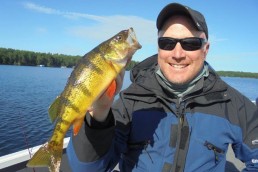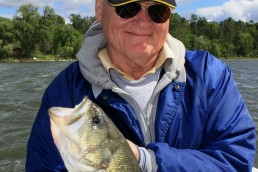2017 Erie Perch Fishing Forecast: ‘Go West’
SHARE THIS POST
Lake Erie yellow perch have long been a popular target for anglers. And they have been my favorite species to catch since my first trips in my grandfather’s Lyman with him and my dad off Catawba Cliffs 50 years ago. In addition to their fantastic attributes on the table, they are available to catch somewhere on the lake year ‘round.
The heaviest fish of the year are in April before they spawn. They typically spawn from March to June, depending upon water temperature, which rises from west to east. A new state record of 2.86 pounds was set last April by Dave Berg while fishing from the shoreline near Fairport Harbor—it was 15 3/4 inches long.
On the lake, good nearshore fishing occurs both in the spring and fall and around deeper areas during summer.
Numerous launching ports provide access to those with boats from the Maumee Bay to Buffalo on the south shore and many also on the Canadian side.
In Ohio, the ODNR DOW uses three Fisheries management units for Lake Erie. District 1 (D-1) is the Western Basin, District 2 (D-2) runs from Huron to West of Fairport Harbor and District 3 (D-3) goes from Fairport Harbor to Conneaut. As a rule, the Western Basin fish run smaller than those found farther east. The typical tradeoff for smaller Western Basin perch is that much greater numbers are usually found in this shallow, nutrient-rich nursery of the lake.
According to DOW’s Lake Erie Fisheries Administrator Travis Hartman, optimal water temperatures favor faster growth in the Central Basin along with adequate food resources. He says that in the Western Basin, high summer water temperatures often result in heavily feeding fish stoking their racing metabolism at the expense of growth.
In recent years, the Central Basin had both size and numbers and anglers took notice. From 2005-2014, a perch-fishing nirvana existed between Cleveland and Conneaut, which drew people from July through the end of the fall boating season. On my very first trip to Conneaut our Charter Captain anchored his 23-foot Crestliner in 46 feet of water where the fish finder indicated a school of perch stacked more than 10 feet thick off the bottom. Within five seconds of the time that I lowered my 3-hook, “crappie rig” to the bottom, I felt fish nibbling and soon reeled in what turned out to be my first “triple-header.” Even better, they were all over 9 1/2 inches long, immediately endearing me to this portion of the lake. On subsequent trips over the next several years, I consistently caught limits of 30 perch that weighed 2 to 2 1/2 fish per pound.
The bounty lasted for the next several years, thanks to a string of good hatches that included the 2003, 2007 and 2008 year-classes based upon the annual Ohio DOW August trawls. However, beginning in 2015, the almost-guaranteed limit catches of the preceding years in Ashtabula and Conneaut became less certain due to poorer reproduction after 2008. According to most reports, fishing was even worse from Vermilion to Geneva.
With multiple year-classes of older perch fading from the scene, catch rates have declined for the past two years in the Central Basin. In D-3, a notable hatch that tallied about half of the average, helped bump up the catch a little in 2012 and another similar hatch in 2016 will support some harvest but at smaller levels than seen in the peak years of 2005-2013.
Factors other than poorer reproduction may impact fishing success too. There was evidence that when the thermocline shifts, a growing low-oxygen “dead zone” may impact perch location, including their position in the water column. There were also high numbers of “bugs,” namely spiny water fleas, in the stomachs of perch during most of last summer. Full stomachs may have influenced their acceptance of the only available bait minnow, golden shiners (aka “Goldies”) that were sold due to the emerald shiner shortages.
During the Central Basin perch bonanza, the Western Basin fishing seemed slow, but catch rates taken from DOW creel surveys varied little from previous years. Fishing effort did decline there in 2014 and 2015 when the algae blooms were severe.
Are you enjoying this post?
You can be among the first to get the latest info on where to go, what to use and how to use it!
The Ohio DOW does young-of-year fish trawls monthly during the summer and fall. The results are calculated as densities of fish per hectare, which equals 2.47 acres. Unlike walleyes, past tagging studies have shown that perch are homebodies that migrate inshore and offshore seasonally, but not as much west to east or east to west, so what hatches locally is what there is to catch in future years.
The running average perch density for the August trawls, the month that is used by both Ohio and Ontario for the “official counts” in D-1, is 432.1/ha. The numbers shown below are preliminary values provided courtesy of the Lake Erie Fisheries Research Units at Sandusky and Fairport harbors.
Since 2003, the Western Basin had poor hatches for eight out of the last 13 seasons. An exception was 2007, with 592.9/ha. The 2010-2012 hatches measured up as extremely poor at 58.2/ha (2010), 29.9/ha (2011) and 74.5/ha (2012) respectively.
However, the past four hatches, from 2013-2016, have been dramatically better and will provide consistent numbers of perch for several years. They tallied 398.7/ha (2013), 668.9/ha (2014), 264.9/ha (2015) and 329.4/ha (2016).
The 2013 hatch entered the fishery late in 2015 as marginal 7-inch “keepers.” They were over 8 inches long last summer and by the end of the season and weighed 3 to the pound, compared to a normal “keeper” weight of 4 to the pound that Western Basin anglers are usually content to keep.
The 2014 hatch was well above average and noticeably added substantially more fish to the western end of the lake. They dominated the catches last summer, growing from 7-inch “dinks” to over 8-inch “keepers” by the end of the fall season. Yet in the Central Basin, with an August long-term average of 342.5/ha, poor hatches have occurred in D-3 since 2008 in all but 2012 (154.3/ha) and 2014 (45.8/ha). The 2016 hatch was measured to be 156.9/ha, which will help beginning in 2018.
D-2 numbers appear to be much worse with only a fraction of the tallies seen since 2008, even in 2012 (65.9/ha) and 2014 (33.6/ha), compared to the district’s long-term average of 189.1/ha.
The DOW creel surveys indicated that from 2014 to 2015, yellow perch harvest climbed 24 percent in the Western Basin, while declining 57 percent in D-3 according to the DOW 2015 Lake Erie Fisheries Status report.
The bottom line of my Lake Erie perch forecast is this: For at least the next few seasons, the Western Basin will take over as the place to go to catch perch. The 2013 and 2014 year-classes are both solid keepers now and will just keep getting bigger. Not only are there are slightly fewer 2-year-old “bait-stealers” from 2015, but they and the 2016 year-class should still be too small to normally attempt to hit baited hooks. By 2018, there will be four year-classes of harvestable perch in the Western Basin that will be available for several years.
The appearance of toxic algae blooms, which will occur in the Western Basin in proportion to rainfall levels through July, may affect an angler’s perch-fishing efforts and perch distribution. Emerald shiner availability will also affect angler participation if the golden shiners are not as effective at catching perch as they became last season.
While there are still perch available in catchable numbers in the Central Basin, including “jumbos” from the 2012 hatch, until there are additional good hatches there anglers will struggle to consistently enjoy the catch rates of recent years.
MWO
SHARE THIS POST
Did you enjoy this post?
You can be among the first to get the latest info on where to go, what to use and how to use it!
John Hageman
John Hageman was manager of Stone Laboratory, Ohio Sea Grant's Biology Station at Put-in-Bay, for 25 years and formerly a licensed Lake Erie ice-fishing guide. He is active with the Outdoor Writers of Ohio and several sportsmen's conservation organizations. He may be contacted at hageman.2@osu.edu.



